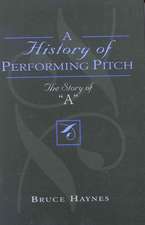Music Theory and Composition
Autor Stephen C. Stoneen Limba Engleză Paperback – 30 ian 2018
Preț: 511.74 lei
Preț vechi: 631.77 lei
-19% Nou
Puncte Express: 768
Preț estimativ în valută:
97.92€ • 106.80$ • 82.57£
97.92€ • 106.80$ • 82.57£
Carte disponibilă
Livrare economică 03-17 aprilie
Livrare express 20-26 martie pentru 52.17 lei
Preluare comenzi: 021 569.72.76
Specificații
ISBN-13: 9781538101230
ISBN-10: 1538101238
Pagini: 520
Dimensiuni: 203 x 254 x 33 mm
Greutate: 1.07 kg
Editura: Rowman & Littlefield
ISBN-10: 1538101238
Pagini: 520
Dimensiuni: 203 x 254 x 33 mm
Greutate: 1.07 kg
Editura: Rowman & Littlefield
Cuprins
Preface
A Note for Instructors
A Student¿s Introduction
Acknowledgments
Preludes ¿ Rudiments
Prelude 1 ¿ Notation of Sound
Prelude 2 ¿ Meter
Prelude 3 ¿ Scales and Key Signatures
Prelude 4 ¿ Intervals
Prelude 5 ¿ Triads
Prelude 6 ¿ Seventh Chords
Part I ¿ Melody
Chapter 1 ¿ Melodic Construction
Chapter 2 ¿ Major Key Functionality
Chapter 3 ¿ Minor Key Functionality
Chapter 4 ¿ Chromaticism in Melodies
Part II ¿ Species Counterpoint to Chorale Style
Chapter 5 ¿ Background for Species
Chapter 6 ¿ First Species in Two Voices
Chapter 7 ¿ Second and Third Species in Two Voices
Chapter 8 ¿ Fourth Species in Two Voices
Chapter 9 ¿ Fifth Species (Florid Counterpoint) in Two Voices
Chapter 10 ¿ Two-Voice Counterpoint
Chapter 11 ¿ Three Voices and Chords
Chapter 12 ¿ First Species in Three Voices
Chapter 13 ¿ Second and Third Species in Three Voices
Chapter 14 ¿ Fourth Species in Three Voices
Chapter 15 ¿ Fifth Species (Florid Counterpoint) in Three Voices
Chapter 12-15 Redux
Chapter 16 ¿ Four Voice Counterpoint and Chorale Style
Chapter 17 ¿ Figured Bass
Chapter 18 ¿ Other Dissonances
Chapter 19 ¿ The Purpose of Chorale Style
Part III ¿ Diatonic Harmony to Form
Chapter 20 ¿ Roman Numerals and Harmonic Progressions
Chapter 21 ¿ Tonic and Dominant: The Fundamental Relationship
Chapter 22 ¿ Predominants: The Basic Progression
Chapter 23 ¿ Intensifying the Motion: Adding Dissonance
1.Sevenths
2.Cadential 6/4
Chapter 24 ¿ Submediant
Chapter 25 ¿ Mediant
Chapter 26 ¿ Harmonic Rhythm
Chapter 27 ¿ Harmonizations
Chapter 28 ¿ Linear Chords
Chapter 29 ¿ Sequences
Chapter 30 ¿ Tonicization
Chapter 31 ¿ Modulation
Chapter 32 ¿ Phrase-level Analysis
Chapter 33 ¿ Small Forms
Part IV ¿ Color Chords and Bold Chromaticism
Chapter 34 ¿ Modal Mixture
Chapter 35 ¿ Neapolitan
Chapter 36 ¿ Augmented Sixth Chords
Chapter 37 ¿ Altered Dominants
Chapter 38 ¿ Enharmonic Reinterpretation
Chapter 39 ¿ Third Relations
Part V ¿ Popular Music
Chapter 40 ¿ Introduction to Popular Music
Chapter 41 ¿ General Stylistic Elements
Chapter 42 ¿ Sonorities from Jazz: Stable Sevenths, Extended Tertian Chords, and Added
Note Harmonies
Chapter 43 ¿ Lead Sheet Notation
Chapter 44 ¿ Pop Progressions Following Classical Diatonic Functions
Chapter 45 ¿ Blues and the Retrogression
Chapter 46 ¿ Mediant and Ascending Thirds
Chapter 47 ¿ Supertonic, Linear Harmonic Motion, and Diatonic Summary
Chapter 48 ¿ Chromaticism from Classical Music
Chapter 49 ¿ Chromaticism from Jazz ¿ Tritone Substitution
Chapter 50 ¿ Pop Chromaticism 1: L and ¿VII
Chapter 51 ¿ Pop Chromaticism 2: Quality Change
Chapter 52 ¿ Three Analyses
Appendices
Appendix A ¿ Melodies for Study
Appendix B ¿ Cantus Firmi and Figured Basses for Exercises
Appendix C ¿ Church Modes
Appendix D ¿ Extended Tertian Harmony
Glossary
About the Author
Descriere
This text presents a pragmatic, accessible approach to music theory through an emphasis on melody and counterpoint. Starting with a single melodic line and gradually adding voices in counterpoint, the book drills part-writing while also explaining functionality, first with scale degrees and then with harmony. Workbook sections follow each chapter.


















